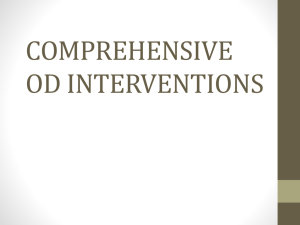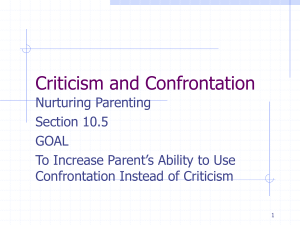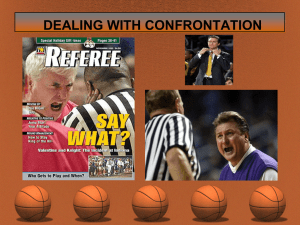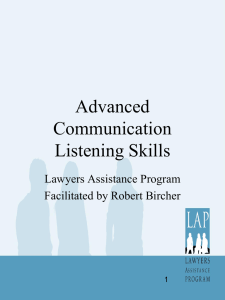Guidelines for Nonverbal Attending Skills
advertisement
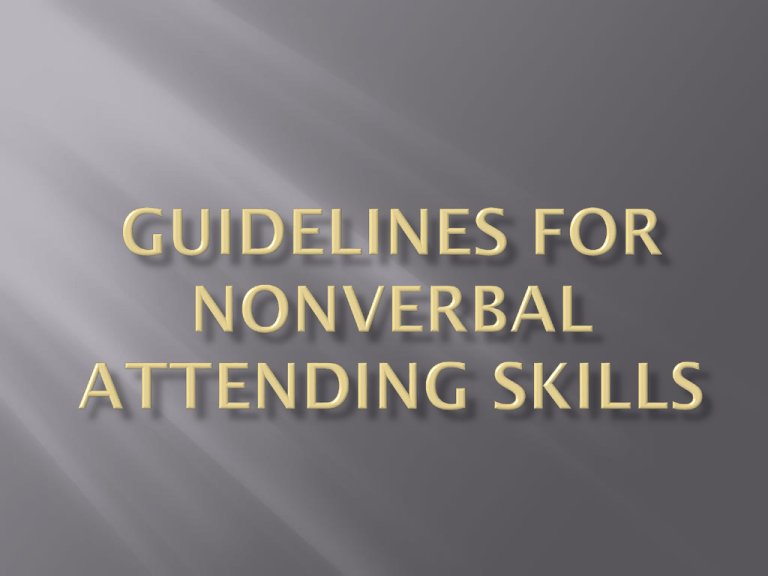
Immediately communicate to the other person without words, that you are attending to them and that you are glad to do it. Be careful that your facial expression is positive. A smile is hard to beat. On some people perplexity, concern and concentration appear more like disbelief or hostility. Use the SOLER position when attending (see box). S it or stand squarely. O pen posture. L ean toward. E ye contact maintained. R elaxed body posture. Gestures animate discussions. Use whatever gestures you are comfortable with unless they are aggressive or patronizing and directed toward the student. Use a friendly tone of voice. Avoid nervous mannerisms, particularly drumming fingers and jiggling feet. These movements communicate impatience with the meeting. Notice how you’re being affected by the other person’s nonverbal messages. Practice and observe. Experience is the best way for you to become adept at picking up the nonverbal cues in yourself and others. Your body is always communicating: Make sure your nonverbal behavior is exerting a positive influence on the other person. Guidelines for Listening Skills RESPECT Value others simply because they are human beings. Be available and willing to help. Suspend your critical judgment. Express warmth. Guidelines for Listening Skills MINIMAL ENCOURAGERS Use small prompts to lead into further exploration or clarification of the student’s needs. “Uh-huh” “Mmm” “Yes” “I see” “Ah” “Oh” Nonverbal nodding of head. Guidelines for Listening Skills REQUEST FOR CLARIFICATION Seek clarification whenever communication is unclear. A simple request is sufficient: “I’m not sure I understand what you mean by…Could you clarify?” Guidelines for Listening Skills QUESTIONS Use open-ended questions to clarify and elaborate. “What …?” “How …?” “Why …?” “When …?” “Who …?” “Where …?” Use closed-ended questions to find facts when the specific situation is known. Jill Hendricks UWG Patient Health Advocate Guidelines for Listening Skills SUMMARY Use summary to clarify. A summary is particularly useful after a long or complicated response. Summarizing helps to keep the student on track. Guidelines for Listening Skills EMPATHY AND PARAPHRASE See the issue from the student’s perspective and communicate this perception to the student. Use empathy to establish a rapport with the student. Be sure to use the proper tone and language. Listen, don’t assume. Understand the student exactly. Communicate your understanding. Guidelines for Confrontation Skills Always take responsibility for the confrontation. Be simple and direct when confronting but proceed openly and smoothly. Exhibit confident and assertive body language; direct but not threatening. Guidelines for Confrontation Skills Be concrete and specific in your confrontation. Confront behavior, distortions, discrepancies, games, etc., in a positive and constructive manner. Make no assumptions about who’s wrong, who’s distorting or who has superior values. Guidelines for Confrontation Skills Identify feelings as feelings rumors as rumors and facts as facts. If tension, social distance or hostility impedes discussion, use immediacy to discuss what is happening in the present moment. Insure that the tone and manner of your challenge does not aggravate the situation. Guidelines for Confrontation Skills If appropriate, focus on the person’s strengths, but don’t confuse the or dilute the confrontation by turning it into a personality buildup session. Defensive Responses Rather than accept the challenge in a positive way, the other person might try to sidetrack or control the confrontation by attempting to: Discredit you as a challenger, implying that you have many faults yourself or are not someone qualified to challenge them. Devalue the issue at hand, implying that it might be true but it is no big deal. Defensive Responses Rather than accept the challenge in a positive way, the other person might try to sidetrack or control the confrontation by attempting to: Persuade you to change your views. This usually takes the form of rationalization. Agree with you, but without sincerity. Ignore any of these attempts and continue to focus on resolving the issue at hand Never argue. Never patronize. Communicate your respect at all times.


